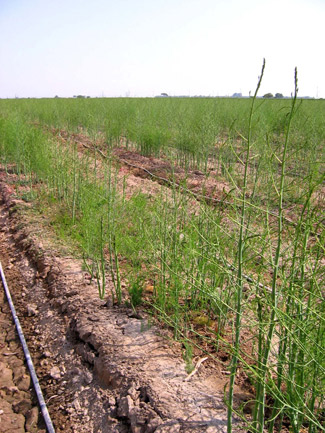Yes, I am aware that making food has absolutely nothing to do with nature or the environment but I simply have to tell you about this recipe I found in Kraft's What's Cooking magazine (also available online here).
It's easy to make, requires very little ingredients, and tastes FANTASTIC.
I modified the recipe a little so this is how I did it and it served 5 people.
Ingredients:
Fettuccine
Philadelphia Cheese (about 250g)
Asparagus (5-6)
Olive oil
Garlic
Pesto (4-5 tbs)
Green Onions (3-4)
Vegetable broth (1/2 cup)
How to:
Boil your fettuccine and add the chopped asparagus for the last couple of minutes.
In a skillet fry up some garlic in a little olive oil before mixing in the Philadelphia cheese, pesto, vegetable broth, and green onions. Let simmer for 3-4 minutes.
Mix the creamy sauce with the drained fettuccine and asparagus. VOILÀ! You have a wonderful meal ready to serve.
I figure to justify this receipe on my nature blog, I'll tell you about asparagus.
Let's start by defining vegetable. The term refers to any part of a plant that is grown for consumption. A carrot is a root, a tomato is a fruit, and what we refer to as asparagus is the young steam (shoot) of the asparagus plant.
It has been classified into the Liliaceae family but I have also found it classified in its own family: Asparagaceae. I'll get back to you on this. Other vegetables in the Liliacea family include garlic, onions, and leek.
 If left to grow, it would become this tall wispy fern-like herbaceous plant with tiny little white or yellow flowers. It's cultivation is a little different from other vegetables. It's perennial because of it's rhizome (underground stem) which produces shoots. The earliest shoots are the best harvest but depending on your growing season, you can have multiple harvests in the same year. A Quebec producer, Mr. Phil Quinn, told me that he waited 1-2 harvest seasons before harvesting his first crop to let the asparagus produce nice thick rhizomes and healthy shoots. Once deamed ready, he harvests twice before letting them grow out and produce seeds. Once they've grown to over a foot in height they don't taste as good so eventhough they are still edible, they are not marketable.
If left to grow, it would become this tall wispy fern-like herbaceous plant with tiny little white or yellow flowers. It's cultivation is a little different from other vegetables. It's perennial because of it's rhizome (underground stem) which produces shoots. The earliest shoots are the best harvest but depending on your growing season, you can have multiple harvests in the same year. A Quebec producer, Mr. Phil Quinn, told me that he waited 1-2 harvest seasons before harvesting his first crop to let the asparagus produce nice thick rhizomes and healthy shoots. Once deamed ready, he harvests twice before letting them grow out and produce seeds. Once they've grown to over a foot in height they don't taste as good so eventhough they are still edible, they are not marketable. Happy cooking!
Take care!
[Picture credits Kraftcanada.com; Kitchenproject.com]



No comments:
Post a Comment